7 Entrepreneurs Tell Us How They Turned Their Passion Into a Thriving Business
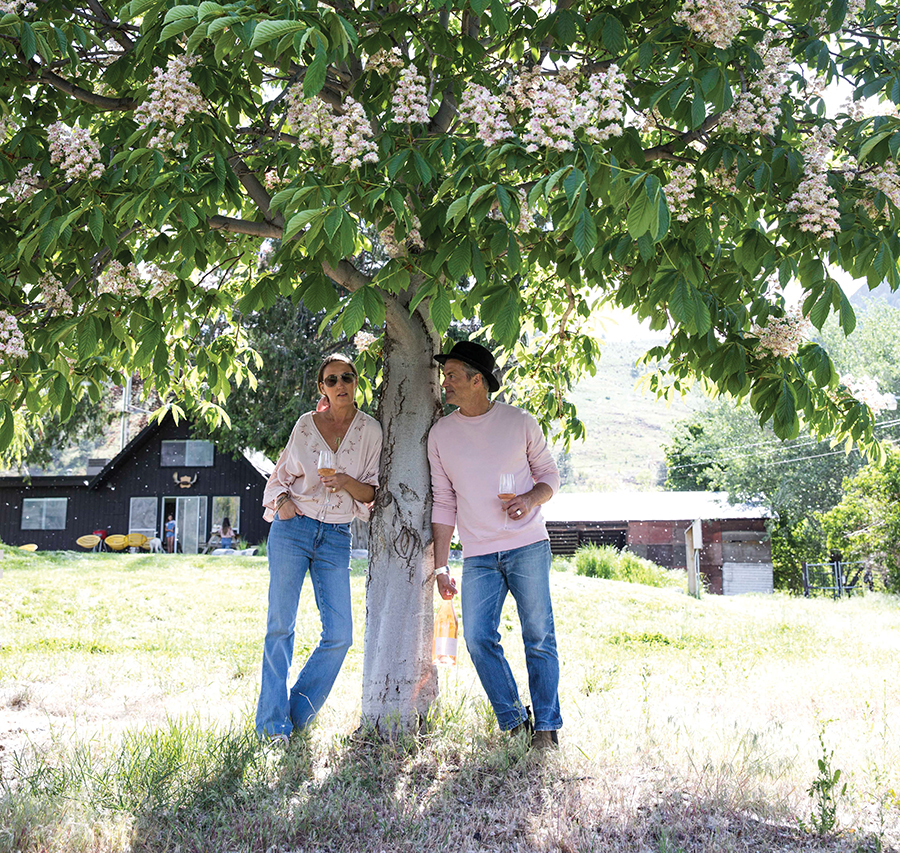
Organic winemakers Sarah and Murray Bancroft Photo by Candace Meyer
Ever dreamed of making a living doing something you love? Seven entrepreneurs took the plunge, creating their own business with their passion at the centre of it. So how did they do it?
Sarah & Murray Bancroft then: a journalist and
a cuisine consultant
Now: Organic Winemakers
The Shift
Sarah: “The online magazine, www.vitadaily.ca, I co-founded in 2004 was acquired by a larger media group in 2013. I was hired by the new company but, two years in, giving my notice was the most liberating feeling ever. At 44, I knew I needed to go back to being an entrepreneur. That winter, Murray and I bid on a foreclosed llama farm in the Okanagan region and converted it into a pinot noir vineyard. A food stylist and culinary consultant and, before that, a chef, for Murray the move from food to wine was like moving to the apartment next door. Still, it was less of a plan than a set of circumstances that fell into place.”
Bottom Line
Sarah: “We created a vacation rental from the vineyard’s 1968 A-frame, sold our condo in Palm Springs and moved to France for a year with our two young daughters. I managed vacation rentals we had in North America while Murray took an online course in viniculture with UC Davis in California while also taking part in harvests in Bordeaux and Champagne. Two years later, Birch Block (birchblockvineyard.com) employs a vineyard manager, a property manager and various graphic designers, cleaners, arborists, irrigators, pickers and landscapers. Making our wine in a co-op, sharing labour costs and equipment, makes it more feasible.”
The Reaction
Sarah: “It was quite a career pivot, but our friends and family were very supportive. Our kids live in constant fear that we’re going to pull them from their Vancouver schools and move to the vineyard. If our dog had his way, that’s exactly what we’d do.”
The Upshot
Murray: “Food and wine have a tremendous power to bring people together and create beautiful memories — that’s quite the reward. We’ve also gained a sense of agency. It’s great to work on your own terms with no ceiling. They say 65 per cent of our kids’ generation will be self-
employed, so it’s good for them to see us hustle.”
The Downside
Sarah: “I’d be lying if I said I didn’t miss the media junkets to Cabo I enjoyed as an editor, but the dirt under my nails is well-earned. Murray often gives me lingerie for Christmas. The year he gave me rubber boots, I knew our lives had changed forever.”
Learning Curve
Murray: “We farm organically, using small-batch natural winemaking practices without sulphites, pesticides or herbicides, which is riskier and more expensive. Most of the work is done manually, and you lose 10 per cent of your annual crop. The learning curve with sustainable biodynamic farming has no end, and I continue to read, research and experiment. As social media is the new storefront, we try to stay ahead of the algorithms. We sold a lot of wine over Instagram this year. We also use Square as a mobile point of sale; people are surprised to see our 10-year-old daughter with an iPad as the cashier.”
Next 10 Years
Sarah: “We’ll most likely be living on the vineyard. We were thrilled with the wine we made this year — rosé and Chardonnay — and blown away when Cactus Club, a North Vancouver restaurant chain that’s expanded across Canada, ordered all of our magnums of rosé.”
Sage Advice
Sarah: “Get that line of credit while you still have a job.”

Violet Jameson then: Banker
Now: Nail Bar & Cafe Owner
The Shift
“Starting as an investment adviser in the ’90s, 25 years later I was executive director in capital markets for one of the major banks. Then, in 2012, I was diagnosed with breast cancer. When I returned to work after chemo, I was miserable. Realizing I’d worked so hard climbing the corporate ladder … but somehow it was the wrong ladder. At 50, I took a year off. I read a lot. I travelled. In Buenos Aires, I noticed how everyone gathered in cafés to socialize. Something we don’t really do in North America where our lives are so scheduled, there’s no spontaneity. I got to thinking how everything happens at the hair salon — gossip, sharing stories — and that getting our nails done is also something we do for fun with friends. And I remembered how, working on Bay Street, I’d have given my first-born for a glass of wine with my weekly manicure.”
Bottom Line
“My retirement package paid me for two years and, when that ran out, I used my savings and deregistered my RSP. I trusted myself and my entrepreneurial instincts: I wanted a fully licenced, artfully decorated nail salon and wine and espresso bar. A hybrid space focused on client experience over a strictly transaction-based model. I hired an architect to create a space with ambiance and an interior designer for the finishing touches. I installed a gallery wall because art makes us feel more creative and a playlist of ’50s jazz to livelier songs from the ’80s because music brings back memories. I commissioned a signature room fragrance. Scent, art, music — the whole experience starts the minute you walk in.”
The Reaction
“A key reason I had the courage to do it was that I’d recently separated, so I didn’t have to convince my husband. He would’ve opposed my leaving a lucrative Bay Street career to open my own business. My marriage was holding me back, not just my job.”
The Upshot
“On Bay Street, I never felt a true sisterhood. Now, I have this amazing group of women, clients and staff, lifting each other up. Yellow Door Studio (yellowdoorstudio.com) hosts wellness workshops, a full moon ritual, weekly tarot readings. And I love having the opportunity to mentor younger staff, to show them their work is valued. Employing mostly immigrant women who, in many cases, were not well treated by previous employers, inspiring them is a huge reward.”
The Downside
“Like any renovation project, it went over budget. But I had this intuition that the concept would work so I managed it. And being an entrepreneur is 24-7 — there’s no delineation between work life and personal life; no ‘waiting for the weekend.’”
Learning Curve
“Social media. I immersed myself. Studying why certain accounts are more appealing; what elements connect and engage followers. After formulating a strategy, I saw how time-consuming it was and that my time was better spent elsewhere, so I hired someone to manage all the platforms.”
What’s Next
“Adding weekly yoga, possibly meditation sessions and a book club.”
Sage Advice
“Learn the power of positive thinking. Ditch a career that’s a burden and build one that affords your life vision and your freedom.”
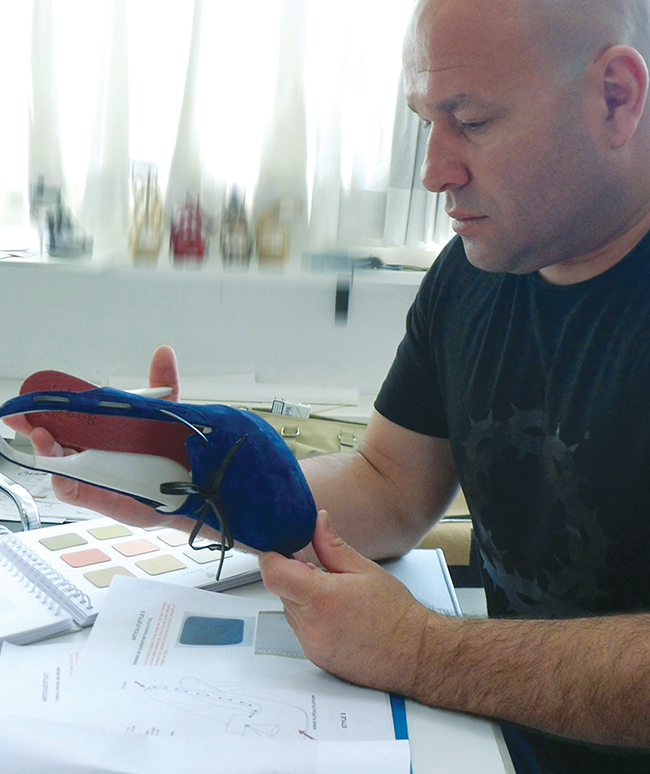
Abel Munoz then: Art Director
Now: Shoe Designer
The Shift
“I spent 15 years as an art director and graphic designer in publishing and advertising. I was always interested in every facet of design but I was fascinated by shoes for as long as I could remember. I started to think about it seriously while working at a fashion magazine. That led me to take the plunge. I began making the professional crossover in my early 40s when I headed to Italy to study shoe design.”
Bottom Line
“I took a 16-week course in Milan in 2010. The Arsutoria School has specialized in shoe design since the 1940s and covered the technical aspects from pattern making, drawing and development to materials and components. I attended workshops and lectures, took research trips to meet artisans and manufacturers. The school tuition was expensive, but I had savings and saw it as an investment in myself. My business has been entirely self- financed, no loans of any kind. I have a team of four in Italy who are paid by the collection, along with the factories that execute them.”
The Reaction
“Some people told me I was crazy. Too old to start a new career, never mind as a shoe designer, and I should continue doing what I knew best. Fortunately, those who mattered to me most, like my husband, supported me all the way.”
The Upshot
“I now have my own luxury footwear brand, Abel Munoz (abelmunoz.com), that’s stocked by leading retailers like Harvey Nichols and Net-a-Porter. It’s been featured in big-time publications like Vogue Italia. Designing shoes is both creative and technical, and I love taking an idea through the development process. The gratification of seeing a concept turn into a finished product is amazing. But what I enjoy most is when women try my designs on. When I look at their faces and see how everything changes when they walk in my shoes.”
The Downside
“Only the time I waited to start doing it! Also, I don’t enjoy the selling process.”
Learning Curve
“It’s been an invaluable experience and a lifetime of inspiration. Spending time in Italy and Colombia, a fashion hotbed in Latin America, I’ve met with manufacturers, artisans and designers who’ve embraced me as their own and taught me so much. But I’m still learning and implementing changes. Fashion is constantly evolving, especially in the digital era.”
What’s Next
“Lots of innovative new collections. I’m being a little cautious but would love to expand. Ten years in, I’m now on the hunt for outside investors. On a personal front, I’d love to be sitting in a trendy place in L.A. having cocktails with Lady Gaga, Rihanna and Cardi B and talking about fashion trends!”
Sage Advice
“Life is dull without taking any risks. Just be aware that it’s a
commitment, and you must be ready for it.”
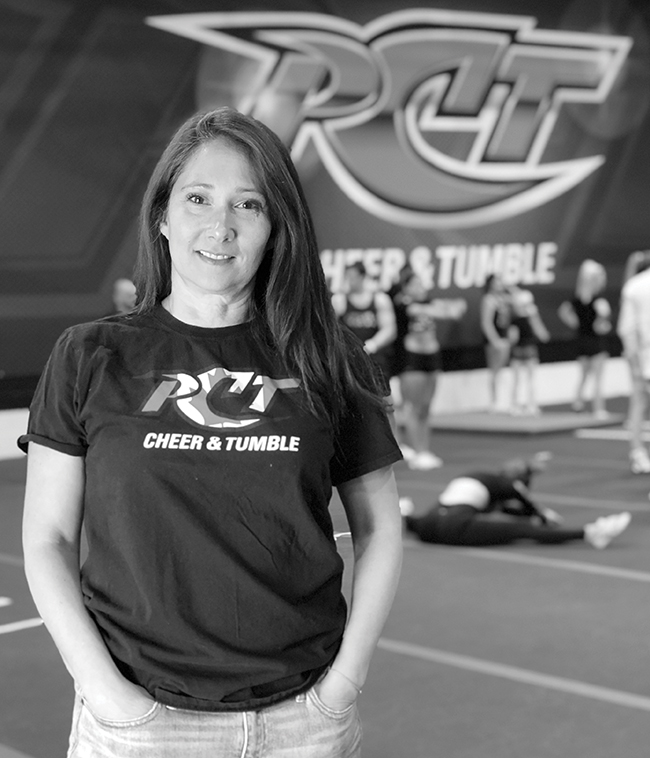
Natalie Vonlanthen then: Advertising Executive
Now: Cheerleading Coach
The Shift
“As an account director and strategist at Toronto ad agencies like J. Walter Thompson, my clients included Petro-Canada, Shell, the Diamond Trading Company and Birks. Marketing was exciting. I travelled, went to galas, lived the ‘dream.’ But before that, I’d run a cheerleading camp in London, Ont., and I’d always wanted my own facility again. I’d continued to volunteer coach an Oakville high school team and, on a whim, I opened PCT Cheer & Tumble as a part time ‘after-hours’ gig. Still working in advertising with multinational clients, I was up early, home late and burning the candle at both ends. Motherhood, my day job, my side job — something had to give. I took a month off to decide and, ultimately, it was my marketing career. In 2010, at 41, I took on the cheerleading business full time.”
Bottom Line
“It was like jumping out of a plane and building a parachute on the way down. I launched the business with no plan. Just a lease on a 5,000-square-foot space and a great reputation as a coach. There were tight times, but we hustled and were smart on expenditures. We treated customers right and grew rapidly. We now employ eight full-time staff, 15 to 22 seasonal part-timers and have been in the black since we opened.”
The Reaction
“My friends and family thought what I was doing was a little non-traditional. Still, they had my back. My boyfriend, who was a hockey coach for years, understands what ‘I can’t, I have practice’ means.”
The Upshot
“Belonging to a real community. I went from being a solitary person with a small circle of friends to the centre of a massive hub of families. Kids come to us as young as four and stay until they graduate high school. I know their families. They become friends. The career I have now shapes the lives of young people. I help them grow true confidence and character. My life today is fulfilling and impactful. I’ve found connection and purpose. I’m more outgoing and empathetic. I feel like the person I was born to be with this job.”
The Downside
“The year our former receptionist embezzled $50,000 in cash. Also, I miss the discount I used to get at Birks.”
Learning Curve
“It was like Mount Everest. We had to learn how to operate from the ground up. We read books. We asked for advice. We joined a Mastermind Coaching Group. We sought out every route to become better business people. It took us a while to find our roles. I remain the marketing person, but times have changed. I worked on big brands with big budgets in traditional media. That’s a far cry from Facebook and Instagram marketing.”
Next 10 Years
“I’m 50, so I’d like to say retired. But I doubt I can give this up. It’s my life’s work and it feeds my soul every day.”
Sage Advice
“I’m a big believer in trusting your gut. Figure out what the hesitation is. Then firmly push it aside.”
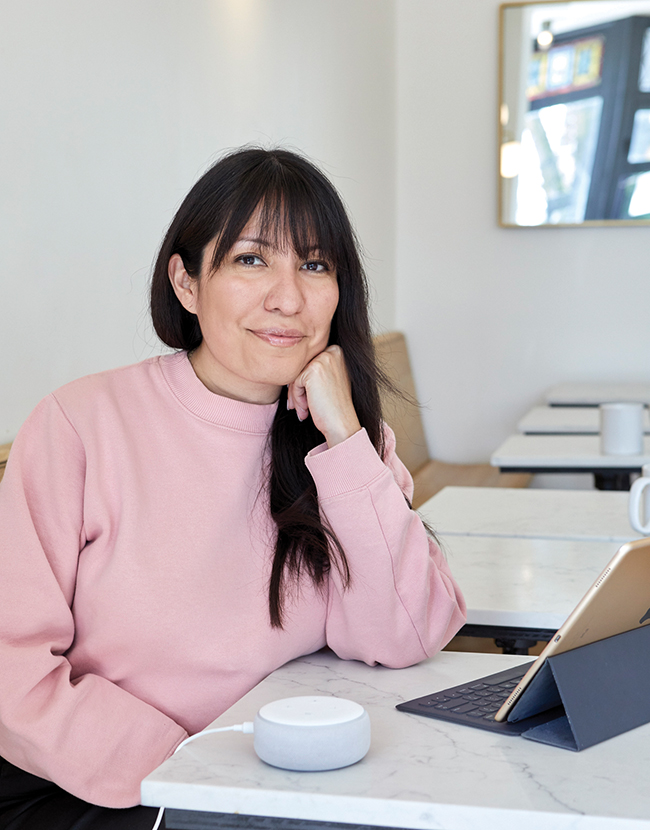
Laura Minquini then: Luxury Brand Marketer
Now: Tech Platform Developer
The Shift
“After working in Toronto magazine editorial, I moved to Paris in 2009 to do brand and trend forecasting for labels like Louis Vuitton. Then I was the director of an accessory brand with licenses like Pantone, working with clients like Apple. By 2017, I had my own Monaco-based consultancy but decided I wanted to do something that contributed to society — not just focus on esthetics. At 38, I was looking for something more meaningful, but nothing was clicking — until I volunteered with my puppy in a retirement home. While I never imagined inspiration would strike there, it did. I saw how marginalized we can become as we get older, and I developed a tech platform that allows people aging at home to remain engaged and independent. A lifestyle concierge and meet-up service powered by voice technology, Mykigai — which translates roughly from Japanese as “a sense of well-being” — is now available as a skill on Amazon Alexa. Services are lifestyle-driven, companionship-oriented and non-medical. Subscribers can request trained providers for social calls and pet visits, along with support for everyday tasks like appointment drives or shopping. We also offer a roster of local events so the community can connect and enjoy new ideas and activities.”
Bottom Line
“It took two years to bring Mykigai to fruition while I ran my consultancy, which funded initial development. Now, I’m taking investors and focusing 100 per cent on the project. The biggest decision was what market to launch in. I’d wanted to stay in Europe, but France meant development in French, and Britain had Brexit.”
The Reaction
“My dachshund, born in Aix-en-Provence, does not love Canadian winters. But in the end, Toronto was the smartest place to be. There’s a thriving new tech scene here that I’m excited to be part of. Also, my parents are getting older and I wanted to be closer to them. It was a nice surprise as they never expected me to move home.”
The Upshot
“Getting out of my comfort zone. I had to reboot myself for a fresh start, and it proved that you’re never too old, it’s never too late, to do something new. I’m learning new things while testing myself and my resolve. I feel invigorated being in North America again — especially in Toronto. It’s changed so much since I lived here. The city feels more cosmopolitan.”
The Downside
“For a while, I was concerned about the effect on my career and losing my network of contacts. But I can eventually incorporate them into what I’m doing as art and design are part of everything. Social media makes it easier to keep tabs on what’s happening in other parts of the world with your friends.”
Learning Curve
“I did a lot of research into areas I was not expert on — aging and start-ups. I’d always been interested in technology but to develop a voice app, I needed in-depth knowledge. I took online courses, tutorials and webinars — there’s an amazing wealth of information online. Research and reading were so important, and the books and courses weren’t that expensive. My biggest and best investment was attending conferences.”
What’s Next
“Expanding Mykigai as a lifestyle brand for positive aging. In the West, we tend to equate it with decline — and that simply should not be the case.”
Sage Advice
“Do it! Regret lies in the things you didn’t do — not the things you did.”
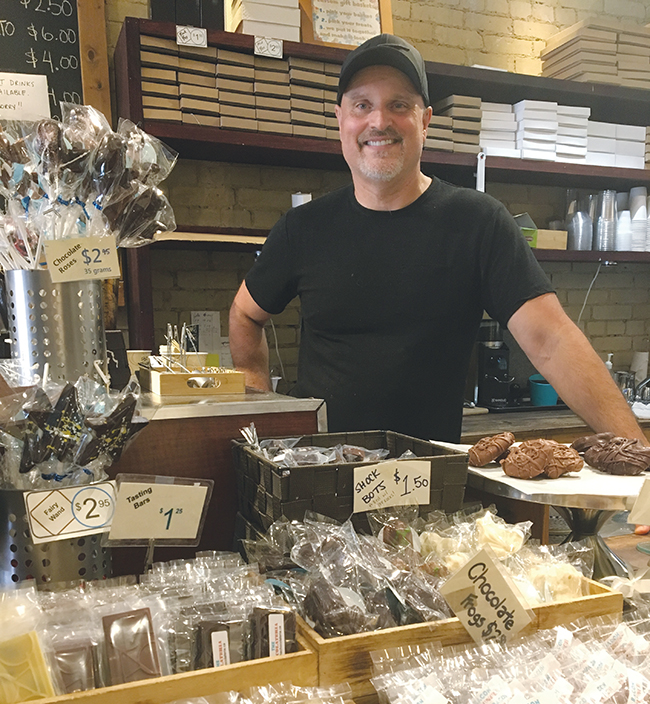
Tim English then: Corporate Lawyer
Now: Boutique Chocolatier
The Shift
“Starting as a Bay Street litigator, then moving to an in-house position doing corporate law in the energy sector, after 20 years, I started to burn out. I’d always wanted to try my hand at my own business — my parents were small business owners — but I wasn’t willing to take the risk. In 2009, I turned 45 and realized if I was going to make the leap, it had to be while I still had the energy and motivation.”
Bottom Line
“I didn’t have a financial plan but, fortunately, I had savings to live on and self-finance. It took a year between leaving my job and opening The Chocolateria (thechocolateria.ca); start-up costs were about 100K. I’d taken baking and chocolate courses at George Brown while still working as a lawyer; otherwise, I learned everything on the job. A lot of trial and error. I looked at 10 locations before choosing Roncesvalles — an up-and-coming area in Toronto that didn’t have a specialty chocolate store but did have a reasonably wealthy demographic that could support this type of business. The space had been recently renovated, so I only had to install equipment and a counter, scavenging shelving out of my own house, yard sales and stuff I found on the sidewalk. I built much of it myself and, nicely, the interior was featured in a design magazine a year after we opened.”
The Reaction
“Some friends thought I was crazy. Others were envious that I was brave enough to make the change. My parents were fine with it as long as I was happy.”
The Upshot
“Freedom and flexibility. Now anyway. Not at the beginning, when it was long, long hours. I enjoy being creative with products and branding; growing a business that, frankly, I never thought would be as successful as it has been. Also, I get to bring my dog, Bandit, with me to work most days; he hangs out in the backyard while I’m in the store. I’m just as fulfilled making chocolate as I ever was closing big deals and gained a new perspective on quality of life. Money and status aren’t everything.”
The Downside
“Staffing is always a challenge. I have three full-time employees and one part-time, usually live-at-home students. The challenges are what you’d expect. I had one employee who was addicted to her phone. I could not get her to put it down.”
Learning Curve
“To find corporate clients, I did a lot of seminars and events at the beginning. We had a lot of positive buzz right out of the gate and, ultimately, word-of-mouth is the best way to promote a business. But one area that I could have done better in was social media. I have a Facebook page and a Twitter account, but most of my customers are local, tend to be a bit older and are not as connected to social media, so I wasn’t rigorous about posting. Now I have my staff to do it — though we still need to improve in that area.”
What’s Next
“New product lines. My customers are repeat customers, so I have to come up with different things to keep them coming back. I’d considered another location but since I’m looking at retiring soon, I haven’t pursued it. I plan to be driving a motorhome around North America — or living in Thailand.”
Sage Advice
“Starting a new career is scary at the beginning — like bungee jumping — but go for it. Just hire a good lawyer and a good accountant.”
For more stories on second acts and career changes, go to www.everythingzoomer.com/flight-plan.